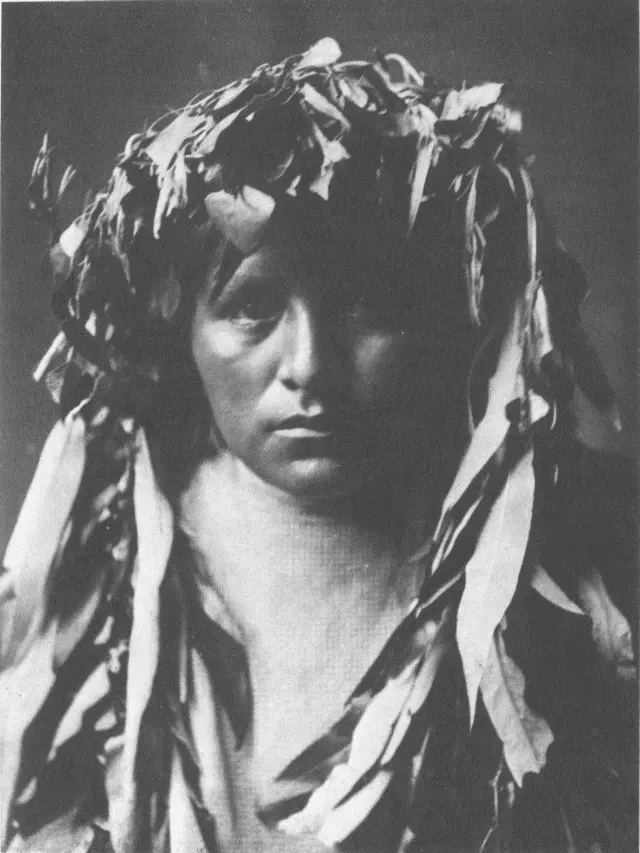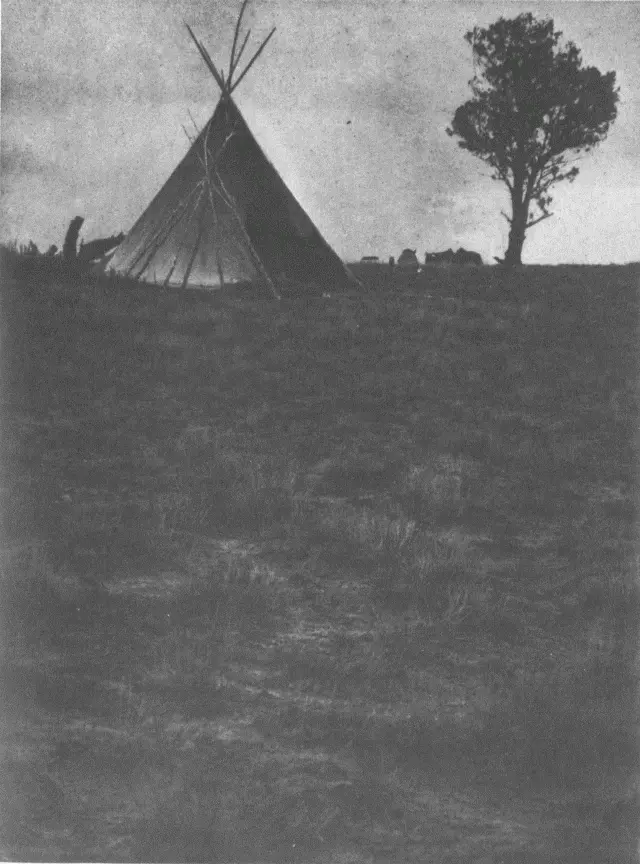This Nalín Bagúdzĭtash, or Girl Dance, is held always at dawn and is brought to a close when the sun shines full upon the participants. The ceremony is conducted by a woman selected from among the friends of the girl's parents for her comeliness, activity, and good character. So far as the performance of the successive parts of the ceremony is concerned, no special knowledge on the part of the leader is required, as a medicine-man is engaged to give the necessary directions and to sing the songs. The girl lies on a blanket upon the ground, and her sponsor, so to speak, straightens her arms and legs, rubs her joints, and otherwise simulates remoulding and beautifying her body. The girl then sits up, and those assembled dance and sing in a circle about her. An eagle feather and a white-shell bead are tied in her hair, and sacred pollen is rubbed on her face, in deference respectively to the bird of war and the god and goddess of health and fructification—Hádĭntĭn Skhĭn and Hádĭntĭn Nalín.
When the dancing is finished the sponsor takes a basket of corn prepared for ceremonial use and deposits it fifty yards or more to the east of the circle. The girl arises and runs around the basket, then back to the blanket on the ground, followed by little boys and girls. The godmother then moves the basket farther away, and the girl runs around it again, followed by children as before. This performance is repeated four times at the east of the circle, after which the basket is carried around to the south and the girl runs around it four times again, then to the west, and lastly to the north. When she returns from her fourth run at the north the girl stops on the blanket as usual, where the basket of corn is emptied on her head. A lively scramble for the corn follows on the part of all present, for it is deemed good fortune to bear away a handful of the consecrated kernels, which, if planted, are certain to be very prolific.
The act of running out and back, followed by children, symbolically attests that the young woman will be strong and active throughout life, beloved by her offspring, who will always follow and obey her. That of pouring corn upon her head is an invocation to the gods that she may be blessed with fruitfulness.
The girl wears her ceremonial raiment of whitened deerskin or new white muslin, with a white feather, a stone bead, and a piece of shell in her hair, for four days after the performance, abstaining during that time from flesh and from food containing salt, being careful, too, not to scratch herself with her fingers. At the end of this period she bathes, dons her usual clothing, and partakes of the customary food.
Table of Contents
The Gáŭn Bagúdzĭtash, or Dance of the Gods, is the one ceremony of the Apache that bears any material resemblance to the many Yébĭchai dances or "chants" of the Navaho, and even then the only feature common to the two is that the men, typifying gods, wear elaborate masks. The Apache are not unfamiliar with the making and employment of dry-paintings for the treatment of the sick, as has been seen. Originally the dry-paintings and the gáŭn, or gods, always appeared together, but in recent years the Gáŭn dance has been conducted preliminary to and as a part of medicine, puberty, and war ceremonies. Captain Bourke, in his "Medicine-men of the Apache" (Ninth Report of the Bureau of Ethnology, 1892), speaks of this as the Spirit or Ghost dance. Though performed infrequently now, as compared with other dances, on account of the expense and of disapproval by the agents, the Gáŭn Bagúdzĭtash is unquestionably the most popular ceremony conducted by the Apache.

Apache Gaŭn
Four always, but generally five, deities are impersonated in this dance—Gaŭnchĭné̆ of the east, Gáŭncho of the south, Gáŭn of the west, Gaŭnchí of the north, and Gaŭnĕskí̆dĕ the fun-maker. These are arrayed in short kilts, moccasins, and high stick hats supported upon tightly fitting deerskin masks that cover the entire head. Each carries two flat sticks about two feet in length, painted with zigzag lines representing lightning.
For the dance a circular plot of ground, fifty or sixty feet in diameter, is cleared of stones and brush, and four small cedar trees are planted about its edge, one at each of the cardinal points. All in attendance assemble in a circle outside the trees, leaving an opening at the eastern side. Unheralded the five masked personators march in from the east and take position in front of the cedar trees, the fifth man standing behind the fourth at the northern side. Four drummers with small drums and an indefinite number of drummers around a large one, at a signal from the medicine-man in charge, who sings, begin drumming. The personated gods dance all about the circle, making motions with their sticks as if picking up and throwing something away, followed by blowing with the breath for the purpose of expelling evil spirits from their midst. While this is going on the fifth masker, Gaŭnĕskídĕ, performs antics designed to amuse the audience. When the songs are finished the dancers depart in an eastwardly direction, whence they came, and all rest.
The drummers begin the next period in the dance by beating their tomtoms. As soon as they commence the gáŭn again appear, coming from the east as before, and stop in single file in front of the cedar tree on the eastern side. There the spectators throw hádĭntĭn upon them and offer prayers, after which the five gáŭn take the same positions as before in front of the small trees. Upon the trees little wheels of cedar twigs have been hung; these the dancers now take, and each dances toward the fire in the centre of the circle and back four times. As the gods dance back and forth the people assembled in the encircling line shift their positions, so that all the women are on the north side and all the men on the south; then the entire body dances, with brief intervals of rest, while twelve songs are sung. The maskers next form in single file on the east, march around the fire, through the flames of which each passes the ends of his two sacred wands to destroy any lurking evil, then back around the eastern cedar tree, again around the fire, then to the southern tree, and so on to each of the four trees, when they take their leave.
This much constitutes that part of the ceremony in which the gáŭn are the chief participants and which usually occupies half the night. The remainder of the night is consumed by the performance of some ceremony forming the principal objective—often the puberty rite above described.

Apache Maiden
Table of Contents

Lone Tree Lodge - Jicarilla
Table of Contents
The Jicarillas, or, as they are commonly called, "Jicarilla Apaches," occupy a reservation of nearly four hundred and fifty square miles of mountainous country in northern New Mexico. Linguistically the Jicarillas are of the same stock as the Apache of Arizona; but here the relationship ceases, for the two peoples have virtually no knowledge one of the other; each, according to their respective genesis myths, had their origin in the general region in which they live to-day, while the dialect, mythology, legends, and medicine rites of the Jicarillas more closely resemble those of the Navaho than any of the Apache groups. The designation "Jicarilla Apaches" is an inheritance from the early Spaniards, who were wont to designate as Apache any warlike tribe which had not been brought under subjection. Such were the Apaches de Nabajú (Navaho), the Apaches del Perrillo, the Apaches Gileños, Apaches Tejuas, Apaches Vaqueros, Apaches Faraones, Apaches Llaneros, Apaches Lipanes, and a host of others, of whom the Spanish missionaries and colonists had little or no knowledge except that derived, alas, from predatory raids on the peaceable Indians among whom they were established. The name "Apache," therefore, was applied in the Rio Grande country of New Mexico in much the same way as the term "Yavapai" was given in the Rio Colorado region of Arizona, and, naturally enough, it still survives.
Читать дальше















